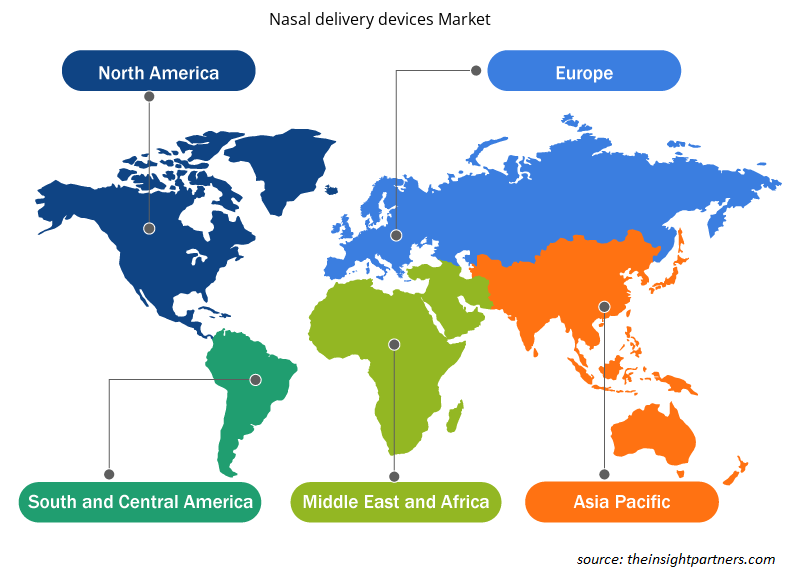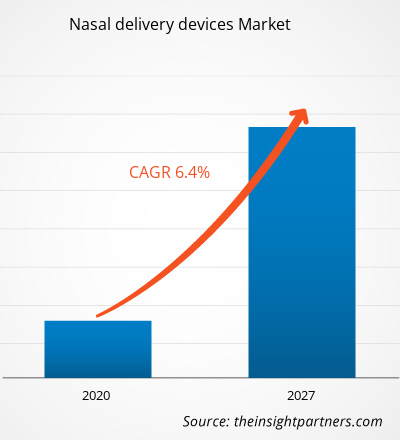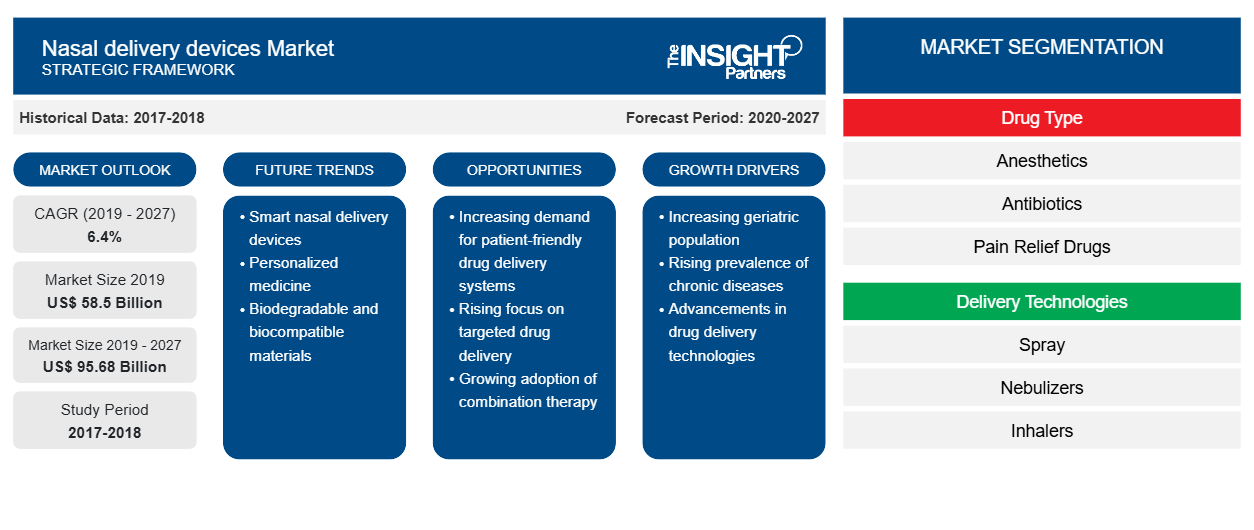Se espera que el mercado de dispositivos de administración nasal alcance los 95.676,62 millones de dólares en 2027, frente a los 58.502,18 millones de dólares en 2019. Se estima que el mercado crecerá a una tasa compuesta anual del 6,4 % entre 2020 y 2027.
La administración nasal de medicamentos es una de las vías de administración de medicamentos preferidas por los pacientes y los proveedores de atención médica. Esto se puede atribuir principalmente a la naturaleza no invasiva de esta vía de administración y a una mayor capacidad de absorción de los medicamentos a través de la vía nasal. Además, la vía nasal ofrece un entorno menos hostil para los medicamentos en comparación con la vía gastrointestinal, lo que permite una mejor absorción del medicamento. La fácil administración de estos medicamentos desempeña un papel crucial en la mejora del cumplimiento de las terapias farmacológicas entre los pacientes, lo que a su vez impulsa los resultados del paciente. Teniendo en cuenta estos factores, la preferencia por la administración nasal de medicamentos está aumentando entre los pacientes y los proveedores de atención médica. Al ser altamente vascular, la cavidad nasal mejora la absorción del medicamento, lo que da como resultado una acción rápida. La Organización Mundial de la Salud (OMS) tiene pautas específicas para los fabricantes, que describen todos los requisitos necesarios para la adopción de nuevos dispositivos de administración nasal con un sistema de administración de un solo uso. Por lo tanto, la administración nasal de medicamentos, a diferencia de otras vías de administración de medicamentos, no requiere métodos estériles estrictos para administrar medicamentos en el cuerpo. Por lo tanto, la alta preferencia por la administración nasal de medicamentos entre los pacientes y los proveedores de atención médica, debido a la creciente conciencia sobre sus beneficios, está impulsando el crecimiento del mercado.
Personalice este informe según sus necesidades
Obtendrá personalización en cualquier informe, sin cargo, incluidas partes de este informe o análisis a nivel de país, paquete de datos de Excel, así como también grandes ofertas y descuentos para empresas emergentes y universidades.
-
Obtenga las principales tendencias clave del mercado de este informe.Esta muestra GRATUITA incluirá análisis de datos, desde tendencias del mercado hasta estimaciones y pronósticos.
Perspectivas del mercado
Prevalencia creciente de enfermedades respiratorias y del sistema nervioso central
Los estudios iniciales de prueba de concepto utilizando nuevos dispositivos de administración de fármacos por vía nasal mostraron resultados prometedores en el tratamiento de enfermedades respiratorias, trastornos neurológicos y otros. Los dispositivos de administración de fármacos desempeñan un papel esencial para garantizar la administración de todo el fármaco al sitio objetivo en la cavidad nasal. En las últimas décadas, se han introducido varios enfoques innovadores de administración de fármacos que podrían superar los desafíos que implica cruzar la barrera hematoencefálica (BHE). Varios estudios científicos respaldan la especulación de que la administración de fármacos a través de la vía nasal puede permitir que mayores concentraciones de fármacos crucen la BHE. La creciente incidencia de trastornos neurológicos aumentaría la demanda de dispositivos de administración nasal. Según la Sociedad Estadounidense de Oncología Clínica (ASCO), en 2020, se diagnosticaron ~3540 tumores cerebrales y otros tumores del SNC en niños pertenecientes al grupo de edad de 0 a 14 años, en los EE. UU. El informe también afirmó que los tumores cerebrales y otros tumores del SNC son los segundos cánceres más comunes entre los niños, lo que representa aproximadamente el 26% de los casos de cáncer en niños con <15 años de edad.
Las enfermedades respiratorias, como las infecciones agudas de las vías respiratorias inferiores, la tuberculosis, la enfermedad pulmonar obstructiva crónica (EPOC, un espectro de enfermedades que incluye la bronquitis y el enfisema), el asma y el cáncer de pulmón se encuentran entre las causas más comunes de enfermedades graves y muertes a nivel mundial. La creciente urbanización y la contaminación, los hábitos y estilos de vida poco saludables y la alta prevalencia del tabaquismo se encuentran entre los factores que conducen al aumento de los casos de enfermedades respiratorias y cardiovasculares. Las respiratorias pueden causar insuficiencia respiratoria aguda, cuyo tratamiento requiere la administración de medicamentos nasales para un apoyo continuo. Según el Informe mundial sobre el asma de 2018, publicado por la Red Mundial del Asma, aproximadamente 330 millones de personas en el mundo son asmáticas. Además, según las estimaciones de la Carga mundial de enfermedades, un proyecto de investigación especial del Instituto de Métricas y Evaluación de la Salud, en 2016, aproximadamente 420 000 personas murieron debido al asma. Según un estudio publicado en los Institutos Nacionales de Salud de la Biblioteca Nacional de Medicina de EE. UU. en 2018, la prevalencia del asma es constantemente alta en Corea, especialmente entre las poblaciones femeninas y de edad avanzada. Además, según el informe Global Burden of Disease Study, la prevalencia de casos de EPOC fue de 251 millones en 2016. Más del 90% de las muertes por EPOC se producen en países de ingresos bajos y medios (PIBM), y es probable que la enfermedad se convierta en una de las principales causas de muerte en el mundo en los próximos 15 años.
Por lo tanto, la creciente prevalencia de enfermedades respiratorias, trastornos neurológicos y otras enfermedades crónicas está impulsando la demanda de dispositivos de administración nasal para la administración eficaz de medicamentos en los sitios de destino.
Información sobre los tipos de fármacos
Según el tipo de fármaco, el mercado de dispositivos de administración nasal se segmenta en anestésicos, antibióticos, analgésicos, suplementos de calcio, vasoconstrictores, antihistamínicos y otros. En 2019, el segmento de antihistamínicos representó la mayor participación del mercado. El crecimiento de este segmento se atribuye al aumento de la rinitis alérgica.
Perspectivas sobre tecnologías de entrega
Según las tecnologías de administración, el mercado global de dispositivos de administración nasal se segmenta en aerosoles, nebulizadores, inhaladores y otros. En 2019, el segmento de inhaladores tuvo una participación importante en el mercado y se prevé que registre la CAGR más alta del mercado durante el período de pronóstico.
Información para el usuario final
Según el usuario final, el mercado mundial de dispositivos de administración nasal está segmentado en entornos de atención domiciliaria, hospitales y clínicas. En 2019, el segmento de entornos de atención domiciliaria tuvo una participación importante del mercado y se prevé que registre la CAGR más alta del mercado durante el período de pronóstico.
Los lanzamientos y aprobaciones de productos son estrategias que las empresas suelen adoptar para expandir su presencia global y sus carteras de productos a fin de satisfacer la creciente demanda de los consumidores. Los actores del mercado de dispositivos de administración nasal adoptan la estrategia de colaboración para ampliar su base de clientes en todo el mundo, lo que también les permite mantener su marca a nivel mundial.
Perspectivas regionales del mercado de dispositivos de administración nasal
Los analistas de Insight Partners explicaron en detalle las tendencias y los factores regionales que influyen en el mercado de dispositivos de administración nasal durante el período de pronóstico. Esta sección también analiza los segmentos y la geografía del mercado de dispositivos de administración nasal en América del Norte, Europa, Asia Pacífico, Medio Oriente y África, y América del Sur y Central.

- Obtenga datos regionales específicos para el mercado de dispositivos de administración nasal
Alcance del informe de mercado de dispositivos de administración nasal
| Atributo del informe | Detalles |
|---|---|
| Tamaño del mercado en 2019 | 58.500 millones de dólares estadounidenses |
| Tamaño del mercado en 2027 | US$ 95,68 mil millones |
| CAGR global (2019-2027) | 6,4% |
| Datos históricos | 2017-2018 |
| Período de pronóstico | 2020-2027 |
| Segmentos cubiertos |
Por tipo de fármaco
|
| Regiones y países cubiertos |
América del norte
|
| Líderes del mercado y perfiles de empresas clave |
|
Densidad de actores del mercado de dispositivos de administración nasal: comprensión de su impacto en la dinámica empresarial
El mercado de dispositivos de administración nasal está creciendo rápidamente, impulsado por la creciente demanda de los usuarios finales debido a factores como la evolución de las preferencias de los consumidores, los avances tecnológicos y una mayor conciencia de los beneficios del producto. A medida que aumenta la demanda, las empresas amplían sus ofertas, innovan para satisfacer las necesidades de los consumidores y aprovechan las tendencias emergentes, lo que impulsa aún más el crecimiento del mercado.
La densidad de actores del mercado se refiere a la distribución de las empresas o firmas que operan dentro de un mercado o industria en particular. Indica cuántos competidores (actores del mercado) están presentes en un espacio de mercado determinado en relación con su tamaño o valor total de mercado.
Las principales empresas que operan en el mercado de dispositivos de administración nasal son:
- Compañía: GlaxoSmithKline plc.
- AstraZeneca
- Pfizer Inc.
- BD
- Sanofi
Descargo de responsabilidad : Las empresas enumeradas anteriormente no están clasificadas en ningún orden particular.

- Obtenga una descripción general de los principales actores clave del mercado de dispositivos de administración nasal
Mercado de dispositivos de administración nasal: por tipo de fármaco
- Anestésicos
- Antibióticos
- Medicamentos para aliviar el dolor
- Suplementos de calcio
- Vasoconstrictores
- Antihistamínicos
- Otros
Mercado de dispositivos de administración nasal: por tecnologías de administración
- Pulverización
- Nebulizadores
- Inhaladores
- Otros
Mercado de dispositivos de administración nasal: por usuario final
- Configuración de atención domiciliaria
- Hospitales
- Clínicas
Mercado de dispositivos de administración nasal: por geografía
-
América del norte
- A NOSOTROS
- Canadá
- México
-
Europa
- Francia
- Alemania
- Italia
- Reino Unido
- España
- Resto de Europa
-
Asia Pacífico (APAC)
- Porcelana
- India
- Corea del Sur
- Japón
- Australia
- Resto de Asia Pacífico
-
Oriente Medio y África (MEA)
- Sudáfrica
- Arabia Saudita
- Emiratos Árabes Unidos
- Resto de Oriente Medio y África
-
América del Sur y Central
- Brasil
- Argentina
- Resto de Sudamérica
Perfiles de empresas
- Compañía: GlaxoSmithKline plc.
- AstraZeneca
- Pfizer Inc
- BD
- Sanofi
- Compañía farmacéutica Merck & Co., Inc.
- Compañía farmacéutica Cadila Ltd.
- Novartis AG
- Laboratorios del Dr. Reddy
- Neurelis, Inc
- Análisis histórico (2 años), año base, pronóstico (7 años) con CAGR
- Análisis PEST y FODA
- Tamaño del mercado, valor/volumen: global, regional y nacional
- Industria y panorama competitivo
- Conjunto de datos de Excel
Informes recientes
Informes relacionados
Testimonios
Razón para comprar
- Toma de decisiones informada
- Comprensión de la dinámica del mercado
- Análisis competitivo
- Información sobre clientes
- Pronósticos del mercado
- Mitigación de riesgos
- Planificación estratégica
- Justificación de la inversión
- Identificación de mercados emergentes
- Mejora de las estrategias de marketing
- Impulso de la eficiencia operativa
- Alineación con las tendencias regulatorias























 Obtenga una muestra gratuita para - Mercado de dispositivos de administración nasal
Obtenga una muestra gratuita para - Mercado de dispositivos de administración nasal